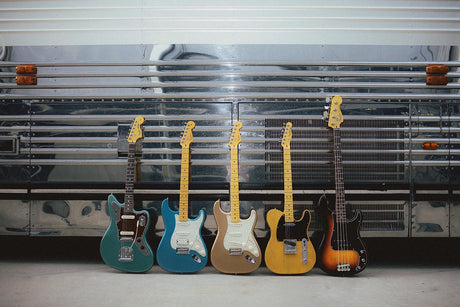The Gibson Les Paul has become an icon within the world of electric guitars and is one of the most popular instruments around. For just one guitar though, there are number of variations and as such, making the right choice for you can seem a little daunting. To help with this, we’ve put together some information that will help highlight some of the major differences between the various Gibson Les Paul models.
What’s the difference?
The essential difference between the Gibson 2019 Les Paul Standard and the Gibson 2019 Les Paul Traditional is that where the former has had modern appointments made to it, the latter has remained relatively untouched. The Les Paul Standard is Gibson’s flagship model and is great in that it changes with the times. As the years have gone by, guitar players’ needs have changed and Gibson have made adjustments to the Les Paul Standard to reflect this. From the 60s and 70s onwards, guitarists wanted a guitar with a hotter output and as such the Standard has higher output pickups than the Traditional. If you want that classic Les Paul sound heard on countless records, then the Standard will give you that, as well as being able to cater for heavier and more contemporary music. Whether it’s jazz, rock, blues, metal, pop, country or anything else you’re playing, the versatile Burstbucker Pro pickups in the 2019 Gibson Les Paul Standard will allow you to get the tone you’re after.
The coil tap function, seen on the Les Paul Standard, splits the pickups and makes them sound more like a single coil. Unlike some other guitars with this function, the the coil split on the 2019 Les Paul Standard, and in fact all of the 2019 Gibsons with this feature, is something you can use in different scenarios to get a wide variety of tones; it’s not just a novelty. If you want to push for higher gain sounds, the Burstbucker Pros can handle anything, whilst still remaining clear and punchy. For the first time in a non-High Performance mode, Gibson have added the internal DIP switch to the 2019 Les Paul Standard, giving you even more tonal options. This allows you to tap or split the coils on your pickups (a bit like choosing between a true single coil and a P90 pickup), you can engage the treble bleed circuit, and even engage the Transient Supression circuit (in simple terms, this is like a built in compressor – great for recording!). Remember, if this isn’t your bag, you don’t have to touch it; not engaging the switches won’t affect your tone.
If you want that Les Paul sound, without any bells or whistles, then the 2019 Les Paul Traditional might be more your thing. It’s still incredibly versatile, but the lower output Burstbucker 1 & 2 pickups, with the slightly weaker Alnico 2 magnets, produce a tone that is perhaps a touch fuller and beefier, like the Les Pauls of the late 50s. These pickups are made roughly to the same spec as the original PAFs which helps the 2019 Gibson Les Paul Traditional deliver a sound that’s dripping in vintage character – in fact, they’re Gibson’s top end PAF style pickup.
Also like the older models, the Les Paul Traditional has a thicker neck profile than the Standard – some people love it; some don’t. The Standard also has a compound neck radius. This means that the fretboard starts off more curved at the bottom, near the nut and gradually becomes flatter towards the top end of the neck. There are players out there that claim fingering chords is easier on a more curved (smaller) radius, and that soloing is easier on a flatter (larger) radius – to find what’s right for you, try both compound and regular fingerboards out. The Les Paul Traditional has a 12″ radius, and stays that way all the way up the neck.
The 2019 Les Paul Traditional features no weight relief. Whilst this does mean that it is heavier than the Standard; in theory, you’re going to get a little more of that luscious Les Paul sustain. The Les Paul Standard on the other hand, has Gibson’s new Ultra Modern weight relief that makes the guitar noticeably lighter – Gibson say that the tone isn’t affected, though some tone aficionados may disagree. Another feature on the 2019 Les Paul Standard is the locking tuners that help your guitar stay in tune for longer; the Traditional has period correct green keystone pegs.
Conclusion
Both of these guitars look, feel and sound like the legendary Les Paul we all know so well. However, there are quite a few differences between them. The Standard does have higher output pickups and has the added versatility of push-pull volume knobs and the internal DIP switch. Having these means that you can easily get a way with taking just this guitar to a gig or session – you can cover everything with just one instrument. The Les Paul Traditional lives up to its name in that it’s charmingly old-school, without any added features. It’s a Les Paul and nothing else, which is exactly what some people are after. Different neck profiles and fretboard radii mean that both guitars feel differently too. Whichever one you decide to go for, you’ll be happy – these instruments are extremely well made and ready to be played!









